How to diversify your business with multi-channel retail
Discussing multi-channel
In this post, we aim to provide answers to the question - what is multi-channel retailing?
And, in pursuit of knowing what is required to update the multi-channel retail model we look at some multi-channel retailing examples.
OMNIS by Iconography
Did you know that our Unified Commerce platform mixes eCommerce, RMS, CRM and EPoS to provide an award winning omnichannel solution?
What is multi-channel retailing?
Multi-channel retailing is a strategy that offers customers a diverse choice of ways to buy products. In its simplest binary form, a multi-channel retailer is a physical bricks and mortar store supplemented by an eCommerce website. And increasingly common is the eCommerce retailer becoming a multi-channel retailer with a bricks and mortar outlet. The consumer will either source online and buy in-store or source in-store and buy online.
New opportunities have arisen in multi-channel retailing. Multi-channel retailing examples now include more digital purchase options. These include new social media channels, online marketplaces, comparison shopping sites and mobile apps. New additions to the established alternative analogue routes open to a multi-channel retailer. The perennials of telephone ordering, mail order, interactive TV shopping and catalogue ordering.
The aim of a multi-channel retailer strategy is always to maximise revenue and customer loyalty by offering customers choice and convenience. Being a multi-channel retailer allows customers to buy what they want, where they want, when they want.
Business success is measured by increases in sales, improvement in margins and reductions in costs from process efficiencies and economies of scale.
Is the multi-channel retailer at a crossroads?
Multichannel retail, with eCommerce as the main driver, is an idea that has been with us for most of this century. As we enter the 2020s the commitment to multi-channel retailing is up for review and renewal. To look forward to defining what is multi-channel retailing let’s first take a look back.
These two charts are from ONS statistics and represent a visual answer to the question of what is multi-channel retailing. They show that for the past fifteen years there’s been a steady growth in eCommerce as a proportion of retail sales up until 2019. You can map many of the successful multi-channel retailing examples to this upward graph. In the peak month of November in 2018 and 2019 internet sales as a proportion of overall retail sales reached 22%. Then, for obvious reasons in 2020, there’s a massive surge to a peak of 37%.
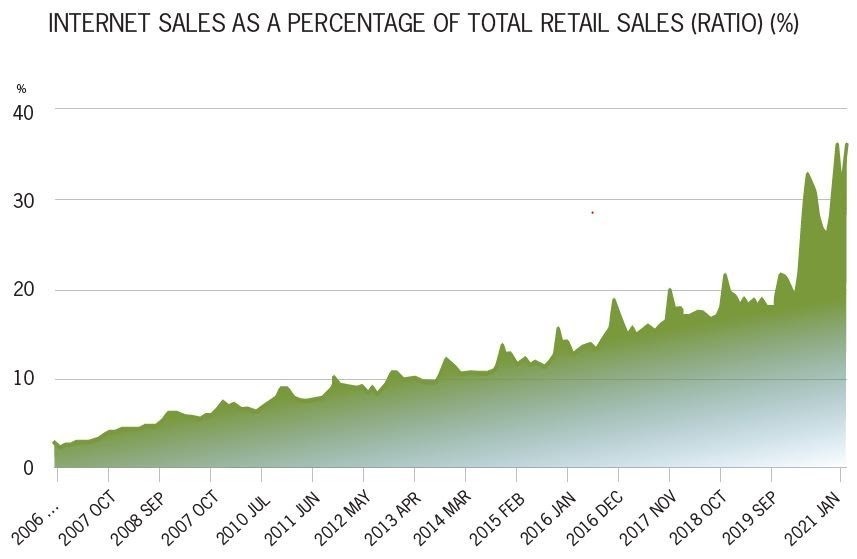
And yet in 2020, again for obvious reasons, we also saw record declines in retail sales volumes, down by 1.9% when compared with 2019. So, overall in 2020 retail sales fell and what was left of them saw a massive shift to online. There are no surprises here given lockdown largely means retail shutdown.
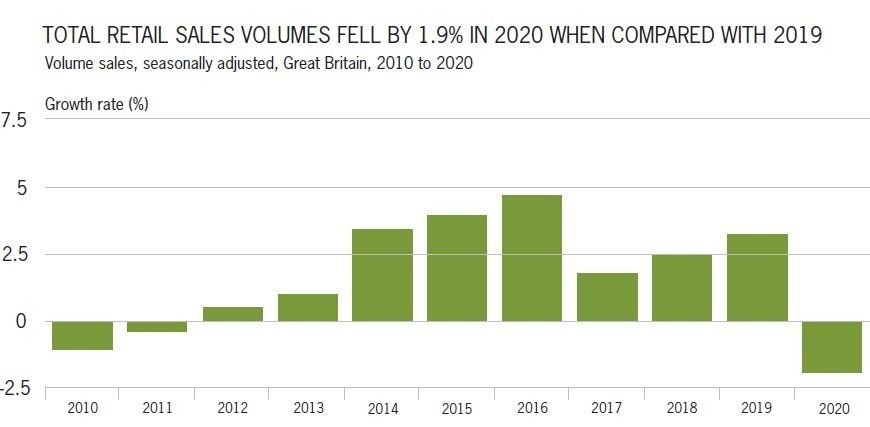
Choosing a multi-channel retail model
The long term trend is clear: more sales are happening online and through digital mobile channels. So, if we are asking the question of what is multi-channel retailing, then it’s safe to say that it’s eCommerce websites and mobile digital. Investment here is the right thing to do and will deliver an increasingly strong return. What is not so clear is how to treat the physical bricks-and-mortar element of a multichannel retail strategy.
Here the answer to what is multichannel retailing will vary because every individual business and sector will have a different experience and perspective. It’s not true that all sectors and high streets have been affected in the same way by the Pandemic. For example, suburban high streets, when permitted to open, have benefited from non-commuting workers. What was prime retail-like Oxford Street in London is now seeing big department stores like John Lewis and M&S converting retail floor space to offices or residential? Across their whole estate John Lewis announced shop closures and a multi-channel retail strategy that reduces bricks-and-mortar. Diversification for them now means non-retail activities like financial services and housing.
Let’s dig a bit deeper into the John Lewis example to illustrate the complexity of updating the multichannel retail strategy:
The Financial Times
The multi-channel retailing model held that customers spent more with their favoured retailers across stores and online, rather than just switching from one channel to another. The ‘halo effect’ of a new store was online sales growth. In fact, John Lewis reports that pre-Covid, £6 in every £10 spent online was ‘driven by’ the shops. Now that has fallen to £3.
The reasons for this are complex and not just accounted for by the rupture in 2020. One significant change is that we are shopping differently - not just more online. This means the old assumptions of the multichannel retail model can no longer be relied upon. The future is not clear. It may be that post-pandemic we will all choose to consume less overall. Buying behaviours may become motivated less by brand and more by price. It may be that we want to buy local when we venture out. All of this uncertainty right now means that the multichannel retail mix of options, while still very relevant, needs to be carefully considered and tailored to your specific needs and circumstances.
Define the challenges & considerations of multi-channel retail
In simple terms, a successful multi-channel strategy offers customers a consistent experience, whichever channel they use. But as the number of channel options increases to include apps, social media, price comparison sites and marketplaces it’s also become more complex to do this effectively.
At the heart of successful multi-channel retailing is a systems and software infrastructure backed up by organisational discipline. With these two as solid foundations, a multichannel retailer can smoothly deliver the consistent customer experience required.
And top of the list for the systems and software infrastructure is one that delivers real-time inventory and order synchronisation across all channels. Don’t let there be any silos of data left in your organisation where product stock or customer order data need a manual update or override. Inaccurate inventory figures that lead to overstock or out-of-stock issues are the main contributor to lost or cancelled sales.
Product data accuracy is also a stumbling block. It’s not just about getting size or colour right to match order to inventory. The different digital platforms and channels available require tailored versions of your product descriptions, features and benefits. Getting it right can help you stand out from the competition; conversely providing insufficient information will lose you the sale.
Remember, success is measured by increases in sales and improved margins. So, when considering a channel expansion, be sure to measure the overall impact and success to avoid cannibalising sales. A marketplace listing that takes buyers away from another channel with lower costs will erode overall margins.
Multi-channel retailing examples
The differences between how companies approach multichannel retail are clear from this top five list.
The Top Multichannel Retailer List was published in Retail week in 2017. Each business comes from a different sector with variable circumstances and commercial drivers. Camera specialist Jessops are not in the top five but are mentioned in the article. They faced massive challenges to their market from the smartphone camera. A tech investment was made and they were willing to bring imaginative solutions to bear on disrupted markets. They are one of many multi-channel retailing examples, showing how multichannel retail strategies can really pay dividends.
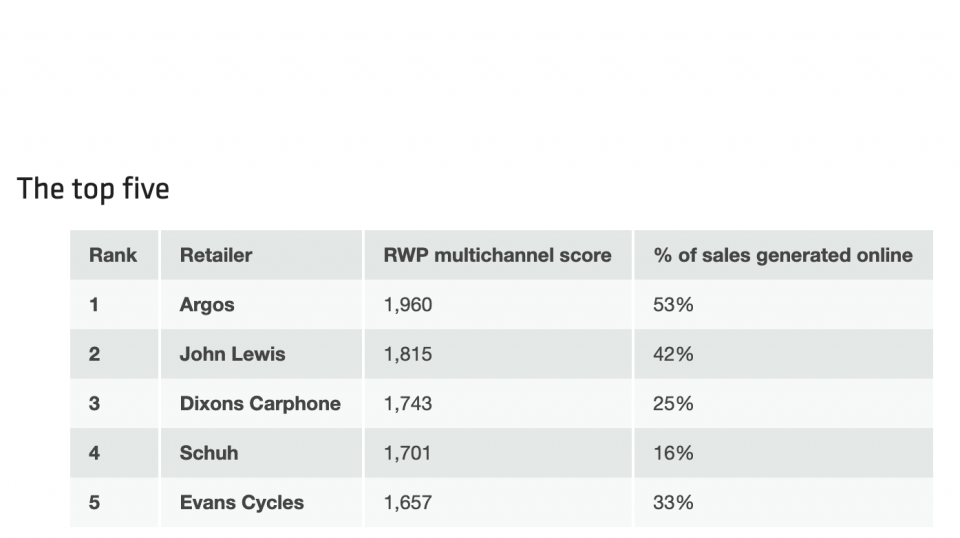
Iconography has a number of successful multi-channel retailing examples from our own customer base. And one of these is Footbalance. In the UK they have a network of physical stores and a strong eCommerce presence. Rather than providing an eCommerce website with a third-party integration to an EPoS system, we were able to offer IXO Commerce. A standalone product that combines both enterprise eCommerce and EPoS - running off a single database. FootBalance UK now has a fully responsive site, connected to the instore till system which allows for fully automated stock control, preventing the ability to oversell items as the stock instantly updates on the database. Rather than the traditional 10 to 15 minute lag time with a third-party integration. A single seamless system that covers every sale, return and customer without needing a single integration.
High street challenges
Running a retail business has always required flexibility and imaginative responses to thrive. The death of the high street has been called many times in the last thirty years. The vagaries of the seven-year economic cycle has always seen an ebb and flow of retail successes and failures. That’s not to diminish the challenges faced by businesses, towns and communities. The rise of out-of-town retail parks from the 1990s put extra pressure on the high street and led to some towns suffering real devastation.
Doncaster is an example where the low levels of town centre office space combine with the massive Meadowhall out-of-town shopping centre to take footfall away and hollow out the old high street and market. Now on top of this, we have the uncertainty of the post-pandemic world, the rapid march of mobile digital and a proliferation of channels. Multi-channel retailing has never been so relevant.
OMNIS Retail
OMNIS was born out of the needs of a leading direct to consumer brand to support their online and instore retailing formats in the UK market. They were facing the same problems and challenges that present obstacles for any retailer.
As a progressive and forwarding thinking brand, our client wanted to remove the limitations, constraints and operational inefficiencies associated with integrating an eCommerce website with offline EPoS and legacy back office retail software.
We quickly saw the vast potential OMNIS possessed. It’s a need we’ve recognised with many other retailers and DTC brands that have similar aspirations and want to remove the restrictions of old retail technology and software.
In OMNIS you can create multiple warehouses with any number of locations, place purchase orders and complete stock transfers. We have a full range of reporting and administrative control suite. Together, these give you complete control and oversight over your stock across all channels.
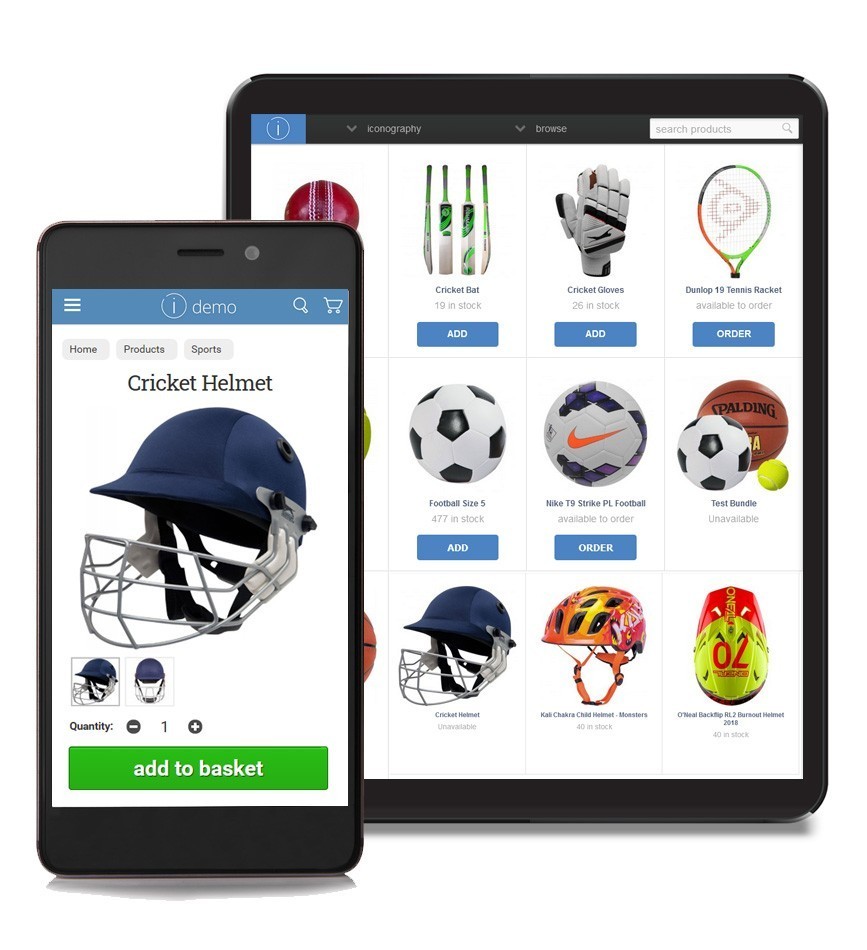
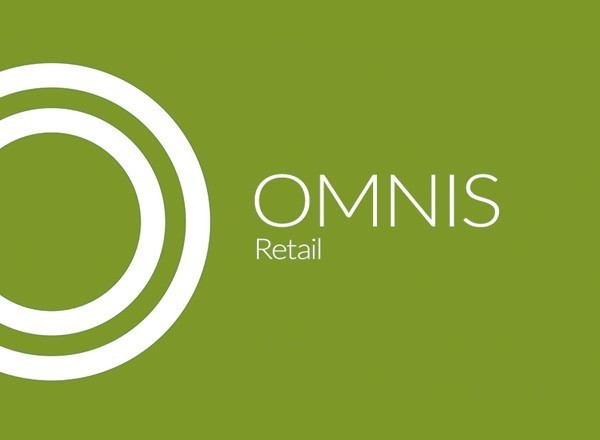
Online and instore retail
OMNIS Retail is a pioneering new retail solution that has been driven by D2C brands & niche retailers looking to the future. A single database eliminates any data integration issues between outdated systems, instead providing a cloud-based omnicommerce retail solution fit for the 21st century.
12th May 2021
We already know that the site maintenance will be a lot easier with the IXO Commerce.
Brian Hume, Martec International
Get in Touch